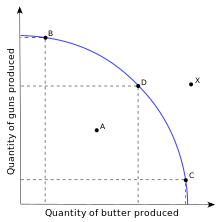
In macroeconomics, the guns versus butter model is an example of a simple production–possibility frontier. It demonstrates the relationship between a nation's investment in defense and civilian goods. The "guns or butter" model is used generally as a simplification of national spending as a part of GDP. This may be seen as an analogy for choices between defense and civilian spending in more complex economies. The nation will have to decide which balance of guns versus butter best fulfills its needs, with its choice being partly influenced by the military spending and military stance of potential opponents.
Researchers in political economy have viewed the trade-off between military and consumer spending as a useful predictor of election success.[1]
In this example, a nation has to choose between two options when spending its finite resources. It may buy either guns (invest in defense/military) or butter (invest in production of goods), or a combination of both.
- ^ Hibbs, Douglas (2010). "The 2010 Midterm Election for the US House of Representatives". CEFOS Working Paper. 9. CiteSeerX 10.1.1.409.410. doi:10.2139/ssrn.1691690. S2CID 154472996. SSRN 1691690.